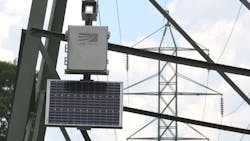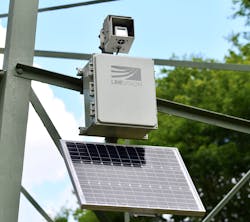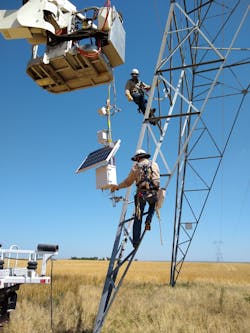Dynamic Line Ratings, Sensing Tech Changing Europe's Transmission System
During the past 15 years or so, there has been a radical transformation in the way electrical energy has been generated to establish a more sustainable future for the world. However, while wind turbine installations have become expansive, utility scale storage has become affordable, and solar has found its path with distributed applications, one of the main drivers of enablement of all these transformative tools has been ignored, namely an ageing and overloaded transmission system.
European electric power utilities have been at the forefront of innovation regarding the rapid ramp-up of renewable sources of power connected to the interconnected transmission system, operated by 42 transmission system operators (TSOs) from 35 countries across Europe (ENSTO-E). In order to meet their ambitious renewable energy goals, power producers and utilities have been forced to think creatively and use a variety of solutions to accomplish a total transformation of the transmission system. While Europe faces familiar obstacles in this mission to rethink how we power the world, a recent initiative funded by the European Commission, aimed at modernizing the European power grid, could be the nexus of a major technology breakthrough in how utilities transmit power to ratepayers.
The European Commission's Facilitating Regional Cross-Border Electricity Transmission initiative (FARCROSS), started in October 2019, is funded by the European Union's (EU's) Horizon 2020 Research and Innovation program. It is a four-year project that intends to connect major stakeholders of the energy value chain and demonstrate integrated hardware and software solutions that will facilitate unlocking of resources for cross-border electricity flows and regional cooperation. Horizon 2020 projects have secured nearly 80 billion euros (US$94 billion) of funding aimed at securing Europe's global competitiveness, and innovative technologies such as dynamic line rating (DLR) from LineVision are being deployed as a part of the FARCROSS project.
FARCROSS project
The FARCROSS project will employ technological innovations to bring forward the additional benefits gained by increasing interconnectivity between neighboring transmission systems that strongly align with the EU's vision and policy, and, most importantly, to:
- Successfully integrate large amounts of renewable generation. These resources are intermittent and there are advantages to geographical dispersion. FARCROSS proposed solutions will be used to increase cross-border flows by allowing other countries to import clean energy, thereby maximizing EU-wide renewable generation.
- Reduce the need to construct new infrastructure by optimizing the existing system, lessening environmental impact created by alternative solutions, and minimizing cost to customers.
- Shorten connection lead times as FARCROSS solutions will be installed in relatively shorter time frames.
Five demonstrations are planned involving eight different countries that comprise applying hardware and software tools to further renewable energy resources penetration and to provide cross-border engagement, improved harmonization, flexible solutions, and forecasting solutions. These demonstrations include:
- Unlocking cross-border capacity with modular power flow control (MPFC) solutions.
- Complex grid management technology for handling transmission line capacity-related issues, for example, DLR.
- Implementation of wide-area protection, automation, and control system (WAMPAC).
- Pan-European deep modeling framework for improved system operation planning/forecasting and analysis at TSO level.
- Co-optimized cross-border capacity auction algorithm.
The FARCROSS consortium consists of 31 partners that include TSOs, distribution system operators (DSOs), market operators, system providers, and manufacturers. The pilot projects for the five demonstrations will take place in eight countries — Greece, Bulgaria, Austria, Hungary, Croatia, Bosnia and Herzegovina, Romania, and Slovenia.
Generation resources
The retirement of fossil-fueled generators and the inclusion of new renewable energy resources present challenges for transmission and distribution (T&D) system operators. This is not a problem unique to Europe. Changes in generation mix and associated challenges are global and are significantly impacting network development policy as well as the range of development technologies used.
The EU's climate and energy packages require the use of more intermittent renewable energy sources, which must be integrated into the existing transmission system. The power generated by these energy resources is highly dependent on weather conditions and this can cause generation peaks that can significantly increase the load on several cross-border transmission line interconnectors. This phenomenon is much more challenging if there is not a normal, but a contingency (N-1) or (N-1-1) operating state. Simultaneously, demand for electricity is increasing because of the electrification of buildings and transportation, placing an increasing load demand on the transmission system. European grids also face many of the challenges faced by TSOs in the United States, which include an ageing transmission system and infrastructure that similarly creates congestion on the existing transmission system. According to the U.S. Department of Energy (DOE), these problems are costing utilities and ratepayers upwards of US$8 billion annually.
Innovative and advanced hardware and software technologies, such as DLR and advanced sensors, will result in benefits for the transmission system in a number of ways. For example, they will alleviate congestion while adding renewable energy generation — all without the burden, time, and cost of building new transmission lines.
"The EU energy and climate policy has led to an increase in the number of renewable energy sources in electricity generation, and the integration of these generating units into the existing transmission system requires a larger, more integrated European system," explained Dr. Balint Nemeth, head of the high-voltage laboratory at The Budapest University of Technology and Economics, and project lead at FARCROSS. "At member state level, energy imports and exports are playing an increasing role, leading to a greater role for cross-border transmission lines. In the current state, however, congestion problems and so-called bottleneck sections that impede the free flow of energy often occur, thereby affecting operational safety and energy prices. Smart investments such as DLR allow for a higher degree of use of the existing network, unlocking extra capacities for system operators. The aim of the FARCROSS project is to build a complex, line monitoring-based DLR system to set up a robust but resilient European grid, thus reducing the potential for bottlenecks on cross-border power lines."
Possible solution
In the EU, one of the possible solutions is to optimize the way power flows through the transmission systems of multiple countries by increasing the capacity at cross-border electricity interconnections. A geographically larger and interconnected transmission system with greater availability of imports and exports of electricity would increase competition, boost the EU's security of electricity supply, and integrate more renewables into the transmission system. However, because of the limited transmission line load transfer capability in Central and Southern Europe, and local differences in the operation of the states' transmission system, congestion problems frequently occur. To enhance the EU's security of electricity supply and in an effort to seamlessly integrate more renewables into the transmission system, there is a need for smart investments such as DLR that enables transmission line capacity to be increased, leading to higher efficiency of energy transports and increased security of supply.
Transmission system congestion occurs during peak-load conditions when critical transmission lines lack the capacity to transmit electricity — whether during times of peak demand or when neighboring lines are taken out of service. Hence, when new sources of power generation like renewables come online, this congestion is exacerbated. This results in the curtailment or loss of clean renewable generation, which is replaced by more expensive gas, coal, or lignite-fired generation closer to the load center.
FARCROSS 2020 cross-border projects
The planned FARCROSS 2020 program of cross-border projects involving transmission line capacity-related issues that require the installation of real-time DLR sensors are as follows:
- HOPS (Croatia TSO): Internal line — Senj-Melina (CR), June 2020
- MAVIR (Hungary TSO): Cross-border line — Göd-Levice (Hungary to Slovakia), July 2020
- APG (Austria TSO): Internal line — Ernsthofen-Wallsea (AT), August 2020
- IPTO (Greece TSO): Cross-border line — Thessaloniki to Blagoevgrad (Greece to Bulgaria), September 2020
In June 2020, the Croatian TSO (HOPS) successfully installed sensors on an internal transmission line in Croatia with the cooperation of teams from C&G, Rotech, U/M, and LineVision.
The IPTO Thessaloniki to Blagoevgrad (Greece to Bulgaria) interconnected transmission line is the most used in the Greek wholesale electricity market. Imports/exports are expected to increase significantly next year because of a liberalized electricity market with a large share of renewable energy sources being connected to the pan-European electricity system. Also, the decommissioning of two coal-fired generating units in Greece is expected to create problems on the existing transmission system and increase the country's electricity imports.
Further, DLR projects to be planned include the Zurndorf-Gyor transmission line that spans the Austria and Germany border. This 400-kV transmission line is highly congested and located near major Austrian wind farms. By using data from monitoring to optimize load flow on the transmission lines, a significant amount of previously unavailable generating capacity will become available to supply the increased loads, allowing Austria's wind energy resources boom to continue.
The FARCROSS initiative
European utilities, faced with rapid renewables growth and obstacles to building new transmission lines, are therefore at the forefront of adopting transmission line modernization technologies like advanced sensors and DLR to improve the capacity and flexibility of their existing transmission. LineVision's technology originated from the United States but the company has since expanded internationally with an office in the EU and is a key partner, providing sensors and analytics to European utilities for the FARCROSS initiative.
LineVision's technology represents an advanced, non-contact sensor platform that continuously monitors and forecasts the behavior of transmission line capacity. It detects anomalies and issues real-time alerts on risks. It can also safely unlock additional capacity on existing lines, where and when it is needed the most. The technology provides a data-driven level of situational awareness and predictive analysis to assist European utilities and other grid participants:
- Anticipate potential transmission line outages,
- Increase the capacity of existing transmission lines, and
- Identify the need for proactive replacement — all while enhancing reliability and safety.
DLR technology will provide utilities with forecasted and real-time actionable data to monitor the performance and behavior of transmission assets, unlocking additional capacity.
DLR is used to dynamically increase the ampacity, that is, the maximum amount of power that can be safely transmitted by overhead transmission lines. The ampacity of an overhead line is determined by its ability to dissipate heat into the environment. That heat is produced by Joule effect as electricity travels through the conductor. This, in turn, is dependent on environmental conditions such as the ambient temperature, amount of solar radiation, and, most importantly, wind speed and direction. According to the U.S. DOE, an increase of 1 m/s in winds perpendicular to the transmission line can increase its capacity by 44%.
Description of LineVision's DLR
LineVision's system uses non-contact, tower-mounted LiDAR and EMF sensors that collect critical information about overhead transmission lines to determine conductor position, temperature, DLR, and other properties. The non-contact approach means no outages are required and no hot sticks or helicopters are needed to install equipment, minimizing installation risk, time, and cost. This uniquely allows LineVision's systems to monitor all three conductors in a single circuit or all six conductors in a double circuit transmission line with a single monitoring system, resulting in fewer monitoring systems to accomplish DLR and complete visibility of the asset's behavior.
LineVision's system also provides unprecedented situational awareness data on real-time asset behavior with its LineAware platform. LineAware measures the sag, blowout, temperature, and tension of each conductor phase and provides customizable alerts on anomalies, conductor damage, and limit exceedances, helping to ensure safe operations. This provides total awareness on an overhead line's performance, not just one third of it, when only monitoring one phase with conductor-mounted devices.
LineVision's LineHealth module is a novel approach to condition monitoring that tracks changes in conductor health over time. The system creates periodic LineHealth reports that analyze the effects of extreme weather, annealing from high temperature exposure, conductor elongation, tension deviations, and determine revised safe operating limits.
Long-term benefits of FARCROSS
The long-term benefits of this major project can be summarized as follows:
- It will increase competition in European energy markets.
- It supports the EU's Clean Energy Package ambitions.
- It will enhance regional cooperation in the transmission system.
- It is likely to create an impact lasting beyond the project lifecycle.
- It will improve system security associated with the interconnection of renewable energy resources.
About the Author
Hudson Gilmer
Hudson Gilmer is a CEO of LineVision.
Jonathan Marmillo
Jonathan Marmillo has an MS degree in mechanical engineering from Lehigh University and is co-founder and vice president of product management at LineVision. Prior to his work at LineVision, Marmillo held a variety of sales and commercial leadership roles at General Electric, where he worked for a decade to help electric utilities operate more efficiently and reliably by using advanced monitoring and diagnostics techniques. He is an active member of CIGRE and the IEEE PES.


